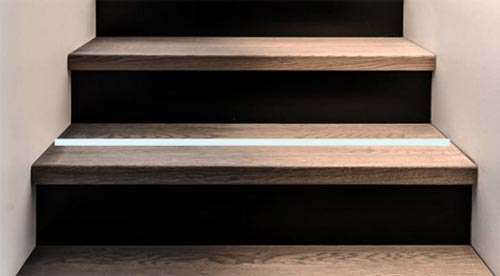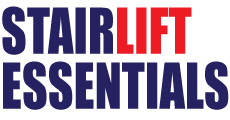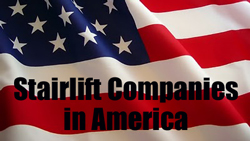Is a stairlift possible on your stairs?
Unfortunately, a stairlift can't be fitted on every staircase. With some staircases, a stairlift could have safety issues for either the person actually using the stairlift or people walking up or down the stairs.
In some cases, there are solutions to these issues, but it will result in you spending more money to install a stairlift.
Below, I'll explain some of the factors (width of stairs, type of staircases and possible obstructions etc...) that determine whether a stairlift can be fitted to a staircase or not. I'll then explain some of the solutions to fitting a stairlift to problematic staircases and the financial consequences of doing so.
Width of the staircase
This is the main factor in deciding whether you can fit a stairlift. If the staircase is narrow, it may not be possible to fit one safely. If a staircase is too narrow, it can cause possible safety issues for both the person using the stairlift (e.g. banging knees against the banister or wall) or for people walking up or down the stairs (e.g. knocking into the actual stairlift and tripping over the rail/track).
For most types of stairlifts, the minimum width which most reputable manufacturers and installers will fix a stairlift on a staircase is around 75 cm (29 inches).
There are some stairlifts which can be fitted to narrower staircases, but these are normally more expensive or are 'perch stairlifts' (where you are stood up on the stairlift instead of seated).
Measuring the width
It is very easy to do. Just use a tape measure to measure the tread (the part which can be walked on) of a step on your staircase (like the white line in the image of a staircase below):

Height of the staircase
In addition to the width of the staircase, the vertical space of the staircase can also determine whether a stairlift can be fitted or not. There needs to be enough unimpeded/clear space where the stairlift will be fitted (so no hand rails, excessively protruding window sills) between the actual stairs and the ceiling.
For most stairlifts, having enough unimpeded/clear vertical space is not normally an issue, but if you are wanting to install a perch stairlift, it could be.
A straight staircase
If you have a straight staircase which isn't narrow, the likelihood that you can have a stairlift fitted is very high. In addition, a straight stairlift is both the quickest to fit and the cheapest to buy.
There maybe some complications if there is door at either the top or bottom of the staircase or no continuous wall. Fortunately in most cases, there are solutions to these problems (which I will talk about later), but the consequence of using these solutions, will increase the price you pay.
A staircase with a bend or curve
Having a staircase which has either a bend in it or is curved makes fitting a stairlift more complicated than with a straight staircase. But unless the staircase is too narrow, the likelihood that you can have a stairlift installed is high.
Staircases which have either a bend in them or are curved require a made for measure rail/track (called a curved rail). This makes fitting a stairlift to these types of staircases both longer to do and more expensive to buy.
Like with straight staircases, there maybe some complications if there is door at either the top or bottom of the staircase or no continuous wall. In most cases, there are solutions to these (which I will talk about later), but the consequence of using these solutions, will increase the price you pay.
Can it be parked safely?
Another issue is where the stairlift is parked when not in use. Normally, stairlifts are parked at the bottom in the hallway before the actual staircase starts and at the top over the last steps of the staircase, level with the landing. In addition, many stairlifts are foldable (the seat, armrests and foot rest/plate can be folded up) to not obstruct people using the stairs.
In most cases, parking the stairlift in this way doesn't cause any safety issues. But with some staircases it can. If there is a door at either the top or the bottom of the staircase, the stairlift could block it. Or if the rail/track or the actual stairlift when parked obstructs access to the stairs (it's not against a continuous wall).
Fortunately, there are solutions to these problems. If this problem happens at the bottom the stairs, the stairlift can have a foldable part of rail/track. This foldable rail/track is called a 'hinge'. Depending on the model of stairlift you buy, some hinged trail/track are lowered or raised manually, while others are done automatically (called a powered hinge). The stairlift when not in use would be parked when not in use either on the staircase or at the top.
Another solution is to park the stairlift around the side of a staircase (normally next to the bannister). This option can be used at both the bottom and top of the staircase. This can only be done on curved stairlifts (stairlifts that move on a curved rail/track).
Although using either solution will mean that you can have a stairlift installed in your house, they both will increase the price of the stairlift. If you have straight stairs, I would recommend that you use a hinge. The reason why, is because a stairlift which has a curved rail/track can end up being very expensive.
Alterations to your house
Although in most cases no alterations will need to be made to your house to fit a stairlift, sometimes they will have to be. This can be as simple as removing a hand rail on the wall, but in some situations it can be more. To find out what the common alterations which are needed to fit a stairlift are and ways to get them done, read my article on 'The possible alterations to your home to install a stairlift'.
Consult a professional
Until you get a professional to look at your staircase, you won't know for certain either if it is possible to fit a stairlift or around how much it will cost you to have one. Fortunately, most manufacturers and suppliers of stairlifts do free site visits. So, take advantage of one and get somebody to tell you.
I would recommend that you only contact reputable and well-known companies to do the site visit. The reason why you should only get a site visit from these companies, is that you can be 100% sure that they won't install a stairlift if there is any safety risk.
Unfortunately, like everything in life, nothing is for free. You should be aware that the person who'll visit you is basically a salesman. They work on commission, so they'll try to persuade you to buy a stairlift when they visit you. So be prepared.
To learn about what will happen and what not to do when you have a stairlift company do a site visit, read my article 'What to expect when your stairs are measured for a stairlift'.
In conclusion
Fortunately, for most types of staircases (a straight staircase or a staircase which has a bend in it or is curved) a stairlift can be safely installed. But if the staircase is too narrow it may mean that one can't be installed safely or you'll need a special type of stairlift fitted (e.g. a perch stairlift).
In addition, if the stairlift or rail/track obstructs a door or access to the staircase, you may require a customised stairlift (e.g. with a hinged rail/track or with a curved rail/track). This will increase the amount you will pay to have a stairlift installed.
Who to buy a stairlift from
Click on one of the flags below to see a list of reputable companies in that country that you can buy a stairlift from and who they are:




